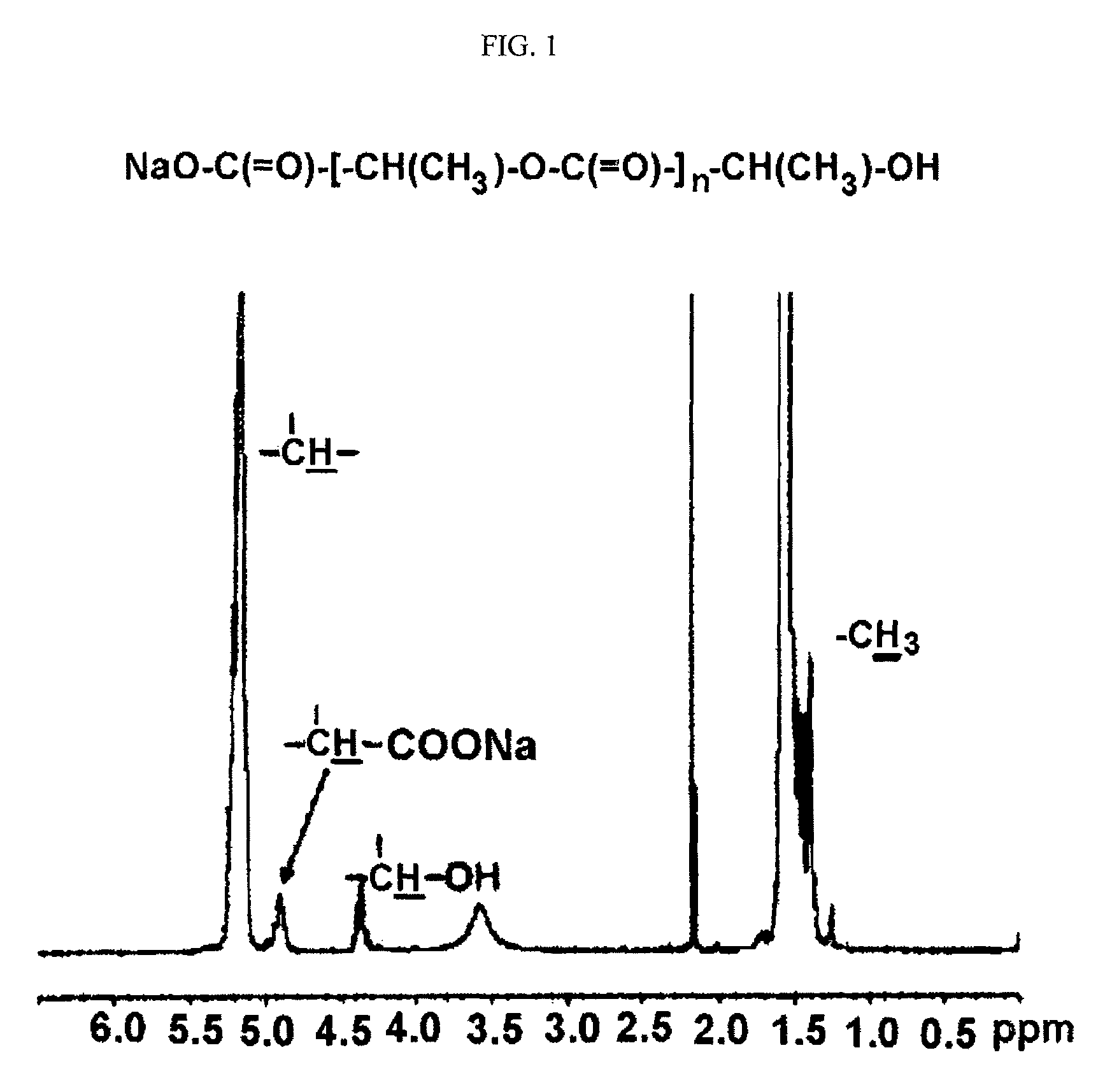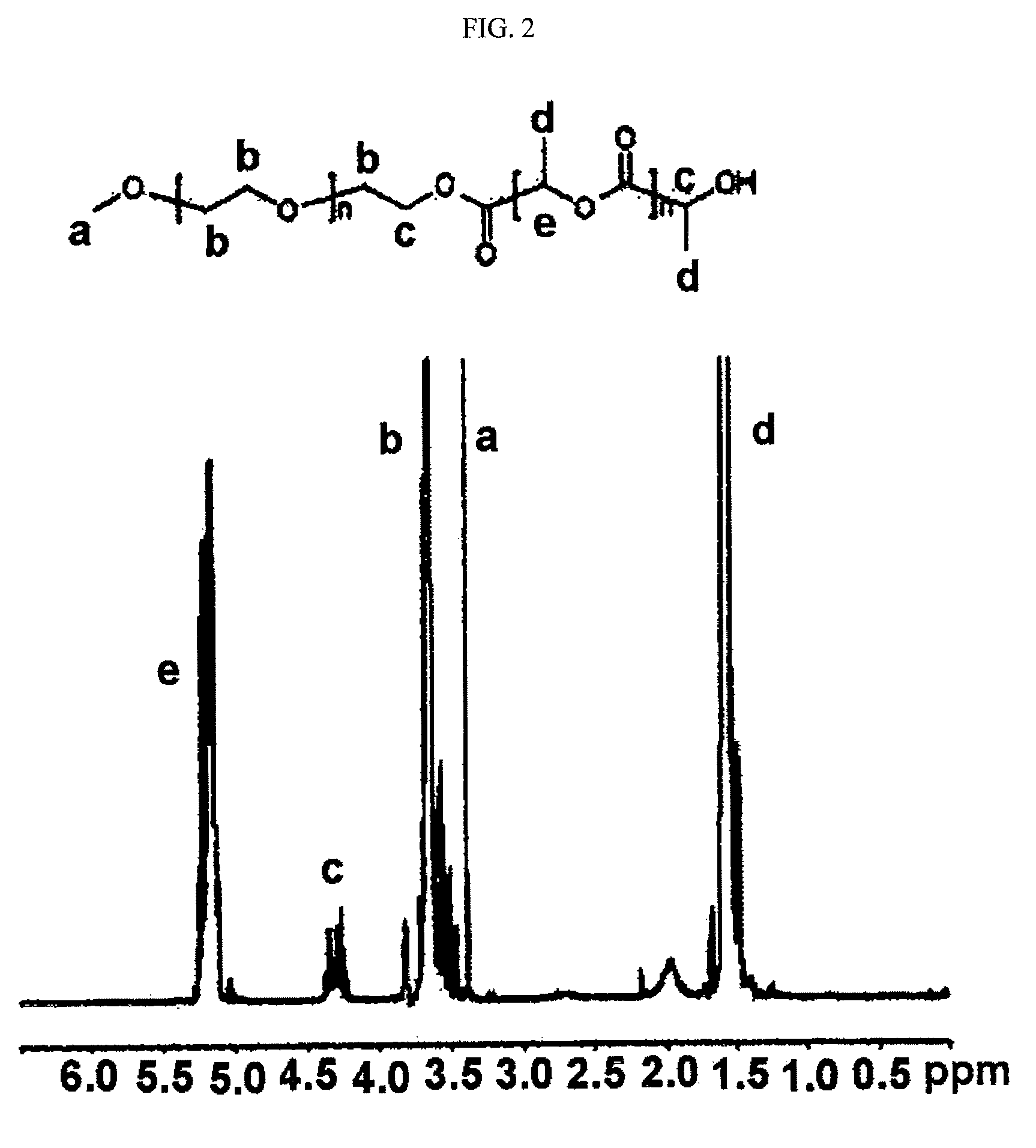Polymer nanoparticle injection formulation composition containing rapamycin with improved water solubility, preparation method thereof, and anticancer composition for combined use with radiotherapy
a technology of polymer nanoparticles and compositions, which is applied in the direction of drug compositions, respiratory disorders, organic active ingredients, etc., can solve the problems of low absolute bioavailability of rapamycin, low absolute bioavailability between individuals, and poor stability of known injectable rapamycin aqueous solutions as aqueous solutions, etc., to increase the anti-cancer effect, and maximize the effect of radiation
- Summary
- Abstract
- Description
- Claims
- Application Information
AI Technical Summary
Benefits of technology
Problems solved by technology
Method used
Image
Examples
preparation example 1
D,L-PLA-COONa (Number Average Molecular Weight: 1,200 Daltons)
[0082]The alkali metal salt of polylactic acid was prepared according to the known methods including those disclosed in Korean Patent Application No. 2002-0063955, etc. That is, 1,000 g of D,L-lactic acid was introduced into a 2 L three-neck round bottom flask equipped with a stirrer. Then the mixture was reacted for one hour in an oil bath at 80° C. under heating and pressure reduction to 25 mmHg with a vacuum aspirator to remove the excessively existing water. The reaction temperature was raised to 160° C. and the reaction was conducted for 7 hours under the condition of pressure reduction to 5 to 10 mmHg, and then the reaction was terminated. As a result, 646 g of unpurified polylactic acid was obtained. The result of measurement by the following NMR analysis showed that the number average molecular weight of the prepared polylactic acid was 1,200 daltons. 750 mL of acetonitrile was added to 500 g of the prepared polyl...
preparation example 2
mPEG-PLA (Molecular Weight: 2,000-1,700 Daltons)
[0084]500 g of monomethoxypolyethylene glycol (number average molecular weight: 2,000) was introduced into a 100 ml two-neck round bottom flask, and dehydrated by heating at 100° C. for 2 to 3 hours under reduced pressure. Dry nitrogen was charged in the reaction flask, and as a reaction catalyst, stannous octoate (Sn(Oct)2) was added by a syringe in amount of about 0.1 wt % (1 g, 2.5 mol) with respect to D,L-lactide, the mixture was stirred for 30 minutes, and then the pressure was reduced (1 mmHg) at 130° C. for one hour to remove the solvent (toluene) used to dissolve the catalyst. 1,375 g of the purified lactide was added thereto, and the mixture was heated at 130° C. for 18 hours. The generated polymer was dissolved in methylene chloride, and diethyl ether was added thereto in order to precipitate the polymer. The obtained polymer was dried in a vacuum oven for 48 hours. The mPEG-PLA as obtained above had number average molecular ...
example 1
Mixed Polymeric Nanoparticle Composition of D,L-PLA-COONa / mPEG-PLA Containing Rapamycin
[0085]20 mg of rapamycin, 895 mg of mPEG-PLA of Preparation Example 2, and 329 mg of D,L-PLACOONa of Preparation Example 1 were solubilized in ethanol, and then the organic solvent was evaporated therefrom by a vacuum evaporator. To the resulting dry product, water for injection was added to make the rapamycin concentration of 2 mg / ml, thereby forming micelles. About 26 mg of divalent calcium ion was dissolved in distilled water to make the mole of calcium ion as ½ of the mole of D,L-PLACOONa, and then the resulting calcium ion solution was added dropwise to the aqueous micelle solution under stirring at 200 rpm to fix the terminal group of polylactic acid salt via the ionic bond, thereby forming the polymeric nanoparticle in which rapamycin was entrapped. The resulting solution was sterilized and filtered through 0.2 μm membrane filter, and then filled in a vial and lyophilized. The measurement r...
PUM
 Login to View More
Login to View More Abstract
Description
Claims
Application Information
 Login to View More
Login to View More - R&D
- Intellectual Property
- Life Sciences
- Materials
- Tech Scout
- Unparalleled Data Quality
- Higher Quality Content
- 60% Fewer Hallucinations
Browse by: Latest US Patents, China's latest patents, Technical Efficacy Thesaurus, Application Domain, Technology Topic, Popular Technical Reports.
© 2025 PatSnap. All rights reserved.Legal|Privacy policy|Modern Slavery Act Transparency Statement|Sitemap|About US| Contact US: help@patsnap.com



